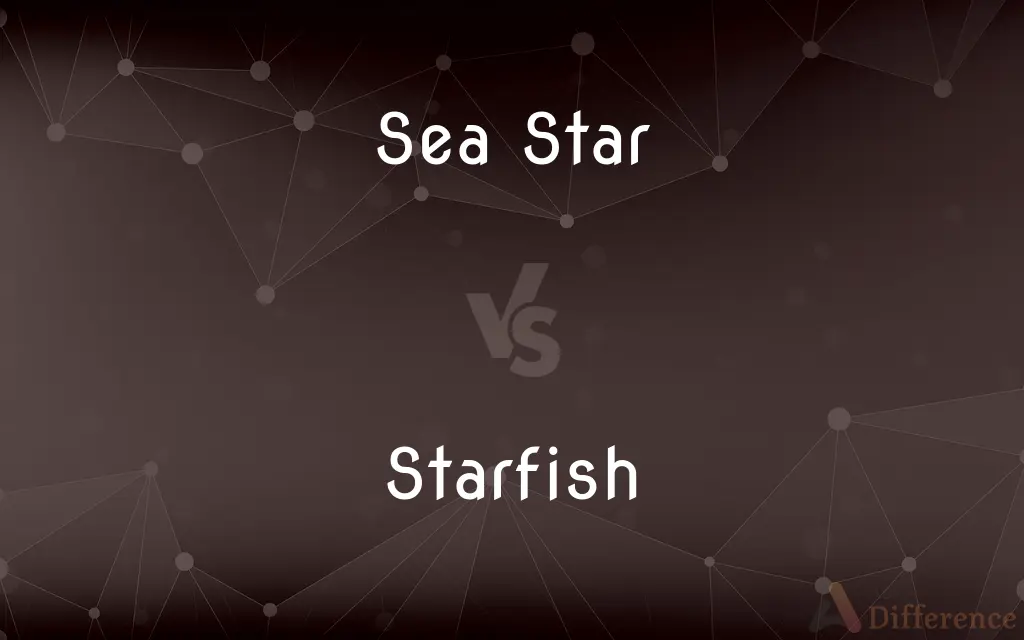Sea Star vs. Starfish — What's the Difference?
By Tayyaba Rehman — Published on November 6, 2023
Sea Star and Starfish refer to the same marine animals, but "Sea Star" is preferred as they aren't true fish.

Difference Between Sea Star and Starfish
Table of Contents
ADVERTISEMENT
Key Differences
Sea Star is a term that has gained prominence in recent times to describe the marine echinoderms that are commonly known for their star-shaped appearance. This name is considered to be more accurate and descriptive, reflecting the creature's nature and habitat more effectively.
Starfish, on the other hand, is the traditional name given to these marine creatures. For years, these organisms have been popularly known as starfish due to their star-like shape. However, this name can be misleading, as it implies that these creatures belong to the fish category, which they do not.
Both Sea Star and Starfish represent the same group of animals. They are members of the Asteroidea class and are characterized by their unique body structure, usually having five or more arms radiating from a central disk. Their unique water vascular system allows them to move, eat, and even regenerate lost limbs.
The shift from the term "Starfish" to "Sea Star" is part of an effort to use more biologically accurate terminology. By using "Sea Star," it clarifies that these animals are echinoderms, closely related to sea urchins and sand dollars, rather than any form of fish.
In essence, while both terms refer to the same marine animals, the preference for "Sea Star" has arisen from the need to avoid misleading nomenclature and to promote a clearer understanding of marine biodiversity.
ADVERTISEMENT
Comparison Chart
Definition
Marine echinoderms
Traditional name for same creatures
Biological Accuracy
More accurate, not a fish
Less accurate, implies being a fish
Origin
Newer terminology
Older, traditional terminology
Usage
Modern, emphasizes accuracy
Common but can be misleading
Relation to Other Terms
Comparable to sea urchins and sand dollars
Suggests relation to fish
Compare with Definitions
Sea Star
Sea Stars can regenerate lost limbs over time.
After an injury, the Sea Star began its remarkable regeneration process.
Starfish
Although called Starfish, they aren't true fish.
Despite its name, a Starfish does not have gills or fins.
Sea Star
They belong to the Asteroidea class in marine biology.
The diversity within the Sea Star species is astounding.
Starfish
Starfish is a term used historically and popularly for these marine creatures.
The Starfish is an iconic symbol of marine life in popular culture.
Sea Star
Sea Star is the modern, biologically accurate term for these creatures.
Researchers prefer using Sea Star over other terms in their studies.
Starfish
Starfish can be found in various sizes and colors.
The vibrant colors of the Starfish caught the diver's attention.
Sea Star
Sea Stars have a unique water vascular system for movement.
The Sea Star's movement is facilitated by its intricate vascular system.
Starfish
Starfish is a traditional name for marine echinoderms with a star appearance.
Children often look for Starfish along the beach during summer.
Sea Star
Sea Star refers to marine echinoderms with a star-like shape.
The Sea Star moved slowly across the coral reef.
Starfish
Their star-like shape has given them their traditional name.
The five arms of the Starfish are easily recognizable.
Sea Star
(obsolete) A star used for navigation or guidance at sea.
Starfish
Any of various marine echinoderms of the class Asteroidea, characteristically having a thick, often spiny body with five arms extending from a central disk. Also called asteroid, sea star.
Starfish
Any of various asteroids or other echinoderms (not in fact fish) with usually five arms, many of which eat bivalves or corals by everting their stomach.
Starfish
(obsolete) Any many-armed or tentacled sea invertebrate, whether cnidarian, echinoderm, or cephalopod.
Starfish
(intransitive) To assume a splayed-out shape, like that of a starfish.
Starfish
(transitive) To form into a splayed-out shape, like that of a starfish.
Starfish
Any one of numerous species of echinoderms belonging to the class Asterioidea, in which the body is star-shaped and usually has five rays, though the number of rays varies from five to forty or more. The rays are often long, but are sometimes so short as to appear only as angles to the disklike body. Called also sea star, five-finger, and stellerid.
Starfish
The dollar fish, or butterfish.
Starfish
Echinoderms characterized by five arms extending from a central disk
Common Curiosities
Why is the term Sea Star becoming more preferred?
"Sea Star" is biologically accurate as these creatures aren't true fish.
Are all Sea Stars and Starfish star-shaped?
Most have a star shape, but some species have more than five arms.
Can Starfish or Sea Stars regenerate their limbs?
Yes, they have an incredible ability to regenerate lost limbs.
Do Starfish or Sea Stars have a brain?
No, they lack a centralized brain but have a complex nervous system.
How do Sea Stars move?
They use their water vascular system and tube feet to move.
Why might the term "Starfish" be considered misleading?
"Starfish" implies they are fish, which they are not.
How do Sea Stars breathe?
They absorb oxygen through their skin and tube feet.
Are Sea Star and Starfish the same creature?
Yes, Sea Star and Starfish refer to the same marine echinoderms.
Can Starfish be found in every ocean?
Yes, they are found in various ocean habitats around the world.
What do Sea Stars eat?
They primarily eat mollusks, coral, detritus, and other small marine creatures.
What class do Sea Stars belong to?
They belong to the Asteroidea class.
Is it wrong to use the term Starfish?
While not wrong, "Sea Star" is more biologically accurate.
Is the Starfish population in danger?
Some species are at risk due to factors like climate change and disease, while others are thriving.
Are Sea Stars important for their ecosystems?
Yes, they play vital roles in marine ecosystems, often controlling populations of other organisms.
Share Your Discovery

Previous Comparison
Easily Carried vs. Easy To Carry
Next Comparison
Single Core vs. Dual CoreAuthor Spotlight
Written by
Tayyaba RehmanTayyaba Rehman is a distinguished writer, currently serving as a primary contributor to askdifference.com. As a researcher in semantics and etymology, Tayyaba's passion for the complexity of languages and their distinctions has found a perfect home on the platform. Tayyaba delves into the intricacies of language, distinguishing between commonly confused words and phrases, thereby providing clarity for readers worldwide.
















































